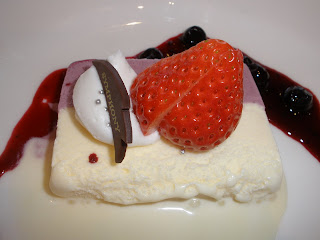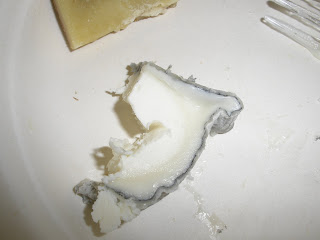Beach scenes plus lots of food in one place...not good for your spring breaking sorority girl, but for a hungry traveler, absolutely perfect.
Okinawa received a ton of influence from other cultures that are not Japanese. It was separate from Japan for many years. Most of its history has it associated as a semi-province of China under the Ryuukyuu kingdom. Japan then came in, then the United States during WWII and the American army still maintains a huge presence on Naha, Okinawa's main city. Throw in the fact that it is a tropical island, the food is very different from mainland Japan. I ate, alot. Not shown here was a 30 dish breakfast that I just gave up on as far as pictures go. Just too many. It was good.
Okinawan sweets. Any restaurant had some form after the meal. The ones on the left are a dark, almost burnt sugar confection. Sugar grows everyone on Okinawa and you can but and taste test these blocks of raw, dark sugar everywhere. Sugar ice pops, raw sugar cane...lots of it around. Right hand side are Chinsukou, a type of biscut made with a ton of butter, some times the dark sugar, but milk, slightly salty and chocolate varieties were also available. Very flaky, beautiful coffee time cracker. Would definitely look for these in America. Surprising elegant for Okinawa's cruder style of food.

Okinawan pork...the Aguu Pig. Host mother went nuts over this stuff. Like most famed Japanese meat, incredibly fatty. I believe this is n uncured, undried bacon portion so mabye comparing fat content isn't fair. What struck me was how white even the lean parts were, not because of fat, just very light flesh. Despite the fat, had a very fresh taste. Tried a bit raw and was probably the best pork I've had. Flavor certainly different than American or other Japanese pork. This went into a nabe with shaved negi (green onions)
 Also at the negi nabe place, we got Koimo tempura with green matcha salt. They are fried sweet potatoes on steriods essentially. Can't go wrong with fried sweet potato but I wanted to point out the contrast between the green salt and purple potato. This is what Japanese food is about...color, presentation. The food looks like a painting, art, and also tastes good.
Also at the negi nabe place, we got Koimo tempura with green matcha salt. They are fried sweet potatoes on steriods essentially. Can't go wrong with fried sweet potato but I wanted to point out the contrast between the green salt and purple potato. This is what Japanese food is about...color, presentation. The food looks like a painting, art, and also tastes good. American influence. Taco rice is a staple on most menus and you can buy the stuff as a mix. Spam also came over in the war and the Okinawans have a hawaii-like fascination with it.
American influence. Taco rice is a staple on most menus and you can buy the stuff as a mix. Spam also came over in the war and the Okinawans have a hawaii-like fascination with it. Okinawa grows many varieties of beans, not soybeans. As a result, their tofu is from sesame or peanuts. This one is peanuts. Peanut tofu tastes somewhat sweet, like peanut butter but not as overwhelmingly oily or strong. The texture is not like soy tofu. It is a bit stretchy, falling close to mochi for elasticity. It is not easily divided with chopsticks like its soy cousin.
Okinawa grows many varieties of beans, not soybeans. As a result, their tofu is from sesame or peanuts. This one is peanuts. Peanut tofu tastes somewhat sweet, like peanut butter but not as overwhelmingly oily or strong. The texture is not like soy tofu. It is a bit stretchy, falling close to mochi for elasticity. It is not easily divided with chopsticks like its soy cousin. After a long price negotiation, host mother bought this bad boy at the market. Like my own mother, kind hearted by a vicious shopper. Market had some of the strangest seafood I've seen. Reds, blues, orange colors. Most still moving since Okinawa is a major fishing port. I think this market was like the Tsukiji of Okinawa. A feeder for all the restaurants. Now what to do with raw fish when you have no fridge. ..
After a long price negotiation, host mother bought this bad boy at the market. Like my own mother, kind hearted by a vicious shopper. Market had some of the strangest seafood I've seen. Reds, blues, orange colors. Most still moving since Okinawa is a major fishing port. I think this market was like the Tsukiji of Okinawa. A feeder for all the restaurants. Now what to do with raw fish when you have no fridge. .. Bring it upstairs to the restaurant that you know (more host mother connections) and turn half into a soup and half into a grilled dish. This "Ebi" (pacific lobster) is all tail meat with the miso (brain and stuff). From the standpoint of a Japanese person, the best you can get. Most americans wont argue with te tail portion either. For claw people...better stick with the atlantic. Meat was incredibly firm. Freshest lobster/shrip I've eaten.
Bring it upstairs to the restaurant that you know (more host mother connections) and turn half into a soup and half into a grilled dish. This "Ebi" (pacific lobster) is all tail meat with the miso (brain and stuff). From the standpoint of a Japanese person, the best you can get. Most americans wont argue with te tail portion either. For claw people...better stick with the atlantic. Meat was incredibly firm. Freshest lobster/shrip I've eaten. This is my new favorite vegetable...gouya. A bitter, lumpy, green squash that looks sort of like a misshapen cucumber. The preparation is called Gouya Champaru and is Goya sliced thin sauteed with egg, pork, tofu. Sometimes fish is substituted for pork. I had it about 4 different times and if done right, all the bitterness goes from the gouya and you are left with a delicous, although somewhat sloppy dish. It stays firm when you cook it, a little crunchy. Hope to find it in the states, this would be a fun and easy dish to make.
This is my new favorite vegetable...gouya. A bitter, lumpy, green squash that looks sort of like a misshapen cucumber. The preparation is called Gouya Champaru and is Goya sliced thin sauteed with egg, pork, tofu. Sometimes fish is substituted for pork. I had it about 4 different times and if done right, all the bitterness goes from the gouya and you are left with a delicous, although somewhat sloppy dish. It stays firm when you cook it, a little crunchy. Hope to find it in the states, this would be a fun and easy dish to make. Okinawa is tropical and has its share of tropical fruit. Pinapple, passion fruit, mango, papaya were all available, although at extravagant prices (not in season...it is winter after all).
Okinawa is tropical and has its share of tropical fruit. Pinapple, passion fruit, mango, papaya were all available, although at extravagant prices (not in season...it is winter after all). Dragonfruit. Most expensive fruit avaiblable. 1500 yen each. Wnated to try but couldnt justify 1500 yen for a piece of fruit.
Dragonfruit. Most expensive fruit avaiblable. 1500 yen each. Wnated to try but couldnt justify 1500 yen for a piece of fruit. Not the first time I saw snake alcohol. Saw about 4 throught the trip. A snake is put in okinawan whiskey until it dies. Then every day you are supposed to drink a little bit. No samples were available.
Not the first time I saw snake alcohol. Saw about 4 throught the trip. A snake is put in okinawan whiskey until it dies. Then every day you are supposed to drink a little bit. No samples were available.








 Course 1: Cold Plate
Course 1: Cold Plate





























